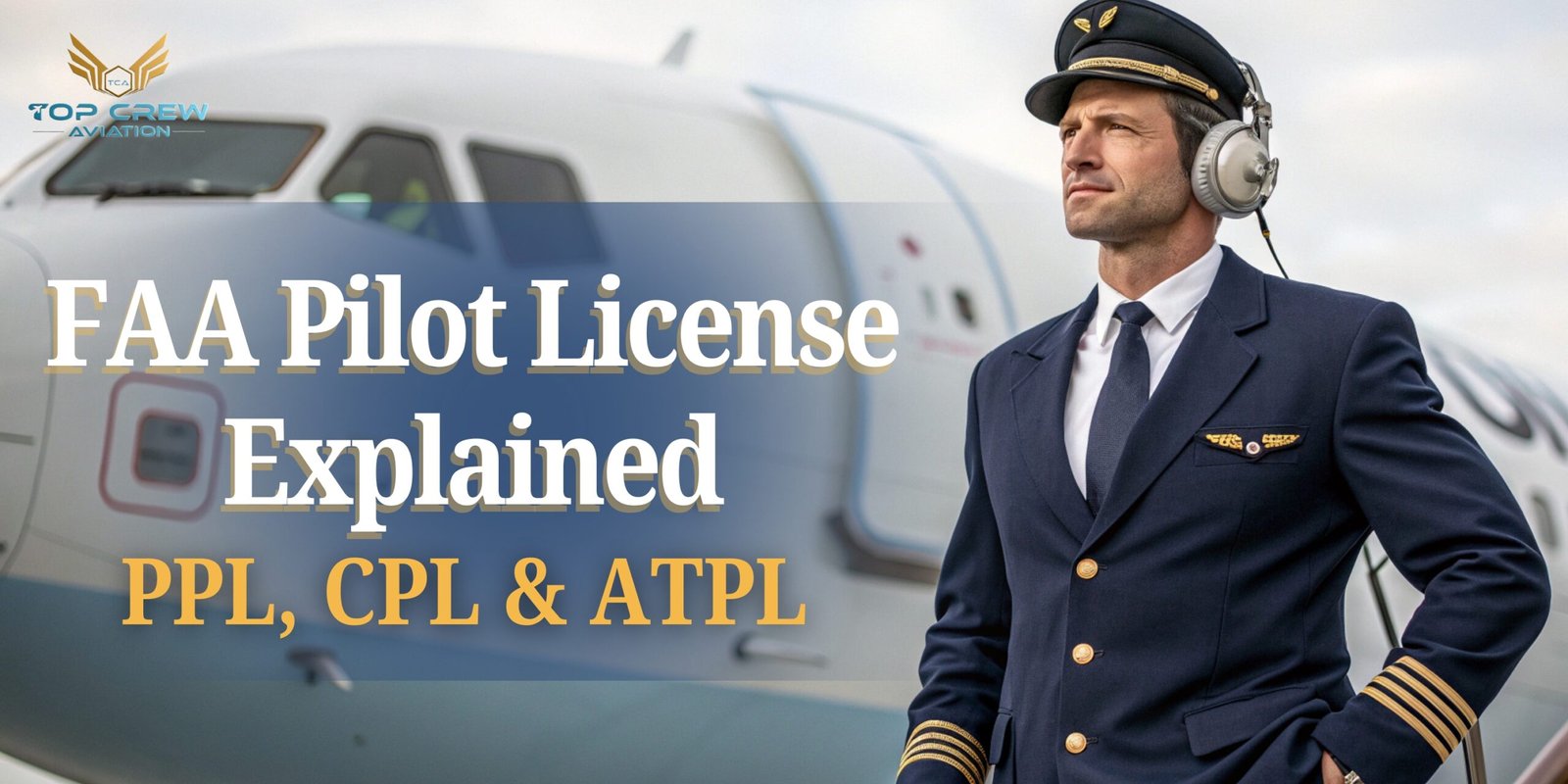Introduction
Flying an aircraft is one of the most exciting career dreams. Many students in India and the USA aspire to become pilots, but before stepping into the cockpit, it’s essential to understand the process of obtaining a Pilot License. Although these licenses vary by location, the journey always begins with proper training and exams.
In this blog, we will explain what PPL, CPL & ATPL are, the differences between them, their eligibility requirements, fees, duration, and why ground classes are essential. You will also learn about the pilot career in India and USA, the requirements for each license, and the top pilot institutes. Finally, we will explain how Top Crew Aviation can guide you in your journey to becoming a professional pilot.
What is a Pilot License?
A Pilot License is an official certification granted by aviation authorities that allows you to fly an aircraft. In India, licenses are issued by the DGCA (Directorate General of Civil Aviation), while in the USA, the FAA (Federal Aviation Administration) handles licensing.
There are three main types of licenses:
- Private Pilot License (PPL): Entry-level license for personal flying. You cannot earn money with this license, but it lays the groundwork for your future earnings.
- Commercial Pilot License (CPL): A Professional license that allows you to work and get paid as a pilot.
- Airline Transport Pilot License (ATPL): The highest-level license required to become an airline captain.
Each license is a step in your aviation journey, and together they form the base of every successful pilot career.
Difference Between PPL, CPL & ATPL
| License | Purpose | Minimum Age | Flying Rights | Career Scope |
| PPL | Personal flying | 17 years | Only non-commercial flying | Foundation step |
| CPL | Professional flying | 18 years | Paid flying jobs | Airline, cargo, charter |
| ATPL | Airline Captain | 21 years (India), 23 years (USA) | Airline captain rights | Highest career stage |
The difference between PPL, CPL & ATPL is clear: PPL gives you freedom to fly for yourself, CPL takes you into the professional world, and ATPL allows you to command large airline aircraft.
PPL, CPL & ATPL Eligibility
Getting a Pilot License requires meeting specific eligibility criteria. These rules ensure that students are medically fit, academically prepared, and ready for professional training. Let’s see the eligibility requirements for India and the USA:
India
Private Pilot License (PPL) Eligibility:
- Age: Minimum 17 years
- Education: 10+2 with Physics & Mathematics
- Medical: DGCA Class 2 certificate
Commercial Pilot License (CPL) Eligibility:
- Age: Minimum 18 years
- Education: 10+2 with Physics & Mathematics
- Medical: DGCA Class 1 certificate
Airline Transport Pilot License (ATPL) Eligibility:
- Age: Minimum 21 years
- Flying Experience: At least 1500 hours
- Prerequisite: Must already hold a CPL
USA (FAA)
Private Pilot License (PPL) Eligibility:
- Age: 17 years
- Education: High school diploma
- Medical: FAA Class 3 medical
Commercial Pilot License (CPL) Eligibility:
- Age: 18 years
- Education: High school diploma (Physics & Math recommended)
- Medical: FAA Class 1 medical
Airline Transport Pilot License (ATPL) Eligibility:
- Age: 23 years
- Flying Experience: 1500+ hours
- Prerequisite: Must hold CPL and pass FAA written and practical exams
Tip: The eligibility rules for a Pilot License in India and the USA are quite similar. The main differences are the age requirement and specific medical certifications, but the overall structure remains consistent for all aspiring pilots.
PPL, CPL & ATPL Course Fees and Duration
The cost and duration of getting a Pilot License can vary depending on whether you train in India or the USA. Let’s break it down clearly:
In India
Private Pilot License (PPL):
- Fees: ₹8–12 lakhs
- Duration: 6–12 months
- PPL is the starting point for your flying career, giving you basic flying experience.
Commercial Pilot License (CPL):
- Fees: ₹35–50 lakhs
- Duration: 18–24 months
- CPL allows you to start working professionally as a pilot.
Airline Transport Pilot License (ATPL):
- Fees: ₹5–10 lakhs (after CPL)
- Duration: 6–12 months
- ATPL is the highest license, preparing you to become an airline captain.
In USA
Private Pilot License (PPL):
- Fees: $10,000–$15,000
- Duration: 4–8 months
- Faster and often more affordable training than in India.
Commercial Pilot License (CPL):
- Fees: $30,000–$45,000
- Duration: 12–18 months
- Many Indian students choose USA CPL training for better cost efficiency and global recognition.
Airline Transport Pilot License (ATPL):
- Fees: $5,000–$8,000 (after CPL)
- Duration: 6–12 months
- Prepares pilots for airline captain roles with required flying experience.
Tip: Training in the USA is often cheaper and faster than in India. Many Indian students opt for USA CPL training to save on costs, gain international experience, and earn a globally recognized Pilot License.
PPL, CPL & ATPL Course Structure and Ground Classes
Every Pilot License course includes two main parts:
- Ground Classes: Cover theoretical knowledge like Air Navigation, Meteorology, Flight Instruments, and Air Regulations.
- Flying Training: Focused on real aircraft training.
- PPL requires 40–50 flying hours.
- CPL requires 200 hours (India) or 250 hours (USA).
- ATPL requires 1500+ hours.
Ground classes are just as important as flying because without theoretical knowledge, no student can pass the exams or fly safely.
PPL, CPL & ATPL Requirements – India vs USA
- India: Regulated by DGCA. Students must get a Computer Number, clear DGCA medicals, and join DGCA-approved schools.
- USA: Regulated by FAA. Students require FAA medicals and TSA approval (for foreign nationals).
These requirements ensure only qualified and safe pilots are granted a Pilot License.
Importance of PPL, CPL & ATPL
Each license has its importance:
- PPL: Builds basic flying skills and confidence.
- CPL: Opens professional opportunities and enables you to earn a living.
- ATPL: The Highest qualification that makes you an airline captain.
Without these licenses, building a successful pilot career in India and USA is not possible.
Pilot Career in India and USA
Building a career as a pilot is exciting, rewarding, and full of opportunities. A valid Pilot License opens doors to domestic and international aviation markets. Let’s explore what a pilot career looks like in India and the USA.
In India
India’s aviation sector has been growing rapidly over the past decade. With new airlines launching domestic and international routes, and regional connectivity programs expanding, the demand for trained pilots is increasing steadily.
- Job Opportunities: Airlines, cargo services, charter flights, and government aviation sectors are constantly seeking skilled pilots.
- Career Growth: Starting with a CPL, you can progress to first officer and eventually airline captain with an ATPL.
- Salary Potential: Entry-level pilots can earn a decent starting salary, which increases significantly with experience and flying hours.
- Challenges: Training costs in India are high, and competition for airline seats is tough. Many students, therefore, consider supplementing their Indian training with additional flying hours abroad.
In USA
The USA has the largest aviation market in the world, making it a hub for aspiring pilots. Here, opportunities are abundant for both domestic and international students.
- Job Opportunities: The USA has numerous commercial airlines, cargo carriers, and private aviation companies constantly hiring pilots.
- Career Growth: Pilots can gain flying hours faster due to the high number of flight operations. Many airlines provide clear paths from first officer to captain.
- Global Recognition: An FAA-approved Pilot License is recognized worldwide, allowing Indian students to work internationally.
- Training Benefits: Training costs in the USA are often lower than in India, and flight schools provide structured programs to complete CPL and ATPL efficiently.
Global Opportunities
A Pilot License is not limited to one country. Once you earn your PPL, CPL, and ATPL, you can explore international airlines, fly for global cargo companies, or even pursue specialized aviation careers such as flight instructors, aerobatics pilots, or corporate aviation.
- Flexibility: Pilots can choose to work in commercial airlines, cargo flights, charter services, or private aviation.
- Travel & Experience: An aviation career allows you to travel the world while gaining valuable professional experience.
- High Demand: Both India and the USA face pilot shortages, ensuring that qualified candidates with a valid Pilot License are always in demand.
Tip: Whether you pursue your training in India or the USA, gaining international exposure and accumulating flying hours significantly boosts your career prospects. Many Indian pilots start training in India and then complete additional flying in the USA to maximize opportunities.
Top Pilot Institutes in India and USA
India
- Top Crew Aviation – highly trusted for expert ground classes and guidance
- Indira Gandhi Institute of Aeronautics (IGIA)
- Bombay Flying Club
- IGRUA (Indira Gandhi Rashtriya Uran Akademi)
- Madhya Pradesh Flying Club
USA
- Embry-Riddle Aeronautical University
- ATP Flight School
- Phoenix East Aviation
- CAE Global Academy USA
- University of North Dakota Aviation Program
These institutes are some of the best choices for getting your Pilot License.
How Top Crew Aviation Can Help in Your Pilot License Journey
Choosing the right institute is very important for success. Top Crew Aviation is one of the most trusted names in India for students aiming to get their Pilot License.
Here’s how Top Crew supports aspiring pilots:
- Expert Ground Classes: Covers all PPL, CPL, and ATPL subjects in detail.
- Step-by-Step Guidance: From DGCA Computer Number to medicals, every process is explained clearly.
- India & USA Pathways: Students can complete ground training in India and continue flying training in the USA for cost efficiency.
- Career Support: Helps students understand the differences between PPL, CPL & ATPL, including requirements and career opportunities in India and the USA.
With its strong reputation and student success rate, Top Crew Aviation is a reliable choice for anyone serious about building a pilot career.
PPL, CPL & ATPL Qualifications – The Step-by-Step Path
Becoming a professional pilot is a step-by-step journey, and each stage of obtaining a Pilot License builds your skills, experience, and career opportunities. Here’s a detailed path:
1. Start with PPL – Learn the Basics of Flying
The Private Pilot License (PPL) is the first step for every aspiring pilot.
- Purpose: PPL allows you to learn fundamental flying skills and understand aircraft operations.
- Training: Includes basic flying hours, ground classes, navigation, and safety protocols.
- Experience Gained: You develop confidence in handling an aircraft, basic navigation, and understanding aviation rules.
- Career Advantage: Although PPL does not permit commercial flying, it lays a solid groundwork for transitioning to CPL.
2. Upgrade to CPL – Begin Working as a Professional Pilot
After completing PPL, the next step is the Commercial Pilot License (CPL).
- Purpose: CPL allows you to start earning as a professional pilot.
- Training: Includes advanced flying hours, instrument training, and additional ground classes covering commercial operations.
- Experience Gained: You learn to handle larger aircraft, understand air traffic regulations in depth, and operate flights under various conditions.
- Career Opportunities: With CPL, you can join airlines, charter services, cargo companies, or private aviation firms.
3. Gain Hours and Upgrade to ATPL – Become an Airline Captain
The Airline Transport Pilot License (ATPL) is the highest level of certification.
- Purpose: ATPL qualifies you to become a captain of a commercial airline.
- Requirements: Minimum 1500 flying hours (varies slightly by country), CPL license, and advanced theoretical knowledge.
- Experience Gained: You master advanced flight operations, leadership in the cockpit, and decision-making in emergencies.
- Career Opportunities: With ATPL, you can command large commercial aircraft, manage crew operations, and take leadership roles in airlines globally.
Why This Path Matters
Following the PPL → CPL → ATPL path ensures that you:
- Build a strong foundation with progressive training.
- Gain sufficient flying experience at each stage.
- Meet international standards for a globally recognized Pilot License.
- Prepare for a successful career as a professional airline captain in India, the USA, or anywhere in the world.
Pro Tip: Many pilots start their PPL in India, complete CPL in India or the USA, and then gain flying hours internationally to upgrade to ATPL faster. This approach maximizes experience, exposure, and career opportunities.
Conclusion
A Pilot License is the foundation of every aviation career. Whether you want to fly for personal reasons or become an airline captain, you need to go through PPL, CPL, and ATPL. Each license builds your skills, knowledge, and career opportunities.
If you are planning your aviation career, carefully choose between pilot training in USA and India, attend quality ground classes, and select a reputed institute like Top Crew Aviation for guidance. With dedication and the proper support, your dream of becoming a professional pilot can take off smoothly.
Suggestion Blog URL:-
How to Become a Pilot in USA
Why USA is the Best Destination for Pilot Training



